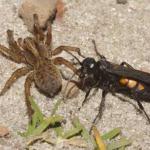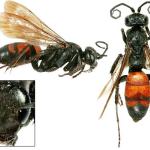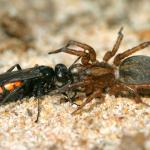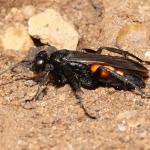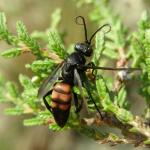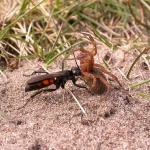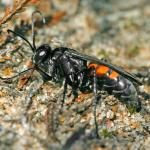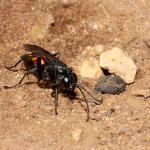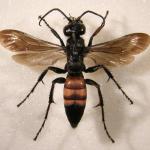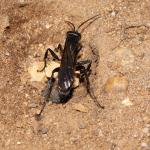Being one of the larger and the most easily identified pompilids, the biology and distribution of Anoplius viaticus is comparatively well known.
Anoplius viaticus occurs from Cornwall to Kent and north to Westmorland. In Ireland, there are a few old records from Wicklow, Fermanagh, Armagh and Antrim.
The species is widely distributed across Europe and central Asia (Wolf, 1972).
This species is not regarded as being scarce or threatened.
Day, 1988 is the standard work for identifying British Pompilidae. Wiśniowski, B., 2009 is also useful.
Sandy soils supporting heaths, dunes and open, heathy woodland.
Females can be found from March to September (and exceptionally from late February). Males are active from June to August. Females which have overwintered survive until June-July but the new generation of females does not nest before overwintering (Field, 1992b).
Spiders of the family Lycosidae form the bulk (up to 70%) of the prey taken (Field, 1992a), with Gnaphosidae, Agelenidae, Thomisidae and Salticidae accounting for the rest (Day, 1988).
Mated females of A. viaticus overwinter and are often one of the first species of aculeate to be seen in the spring. These females hunt for spiders before nest construction and lodge the prey in tufts of grass or other suitable vegetation near the nesting area; occasionally they are deposited on bare ground if no suitable hiding places are available nearby. The prey is then left while a suitable nest site is selected and the cell excavated. The process of site selection and nest construction can take more than an hour. This prolonged period during which the prey is unguarded can lead to the spider being discovered by another female who immediately carries it off and re-sites it before she starts the process of digging her own burrow for the stolen prey. Fights over a spider have also been observed where a hunting female has encountered another dragging its prey to the nest site. The eventual winner is not necessarily the original owner.
Females are reported as commonly feeding on flowers, particularly shepherd's cress in the Brecklands (Field, 1992a). A female has also been reported on a species of willow. Males are often seen feeding on umbellifers.
Brood parasitism may occur with females opening the nests of other A. viaticus females and removing the egg before laying their own and resealing the nest (Field, 1992a). Miltogrammine flies also shadow nest excavating females, presumably to lay their eggs on the prey (M Edwards, pers. comm.).
2001


